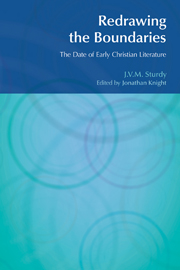Book contents
- Frontmatter
- Contents
- Preface
- Abbreviations
- 1 The Problem Posed
- 2 1 Clement
- 3 The Letters of Ignatius
- 4 Polycarp
- 5 Early Christian Literature: Some Parameters of Date
- 6 The Relationship of the Synoptic Gospels
- 7 Mark
- 8 Luke
- 9 Matthew
- 10 Acts
- 11 The Pauline Corpus: Its Growth and Development
- 12 The Catholic Epistles
- 13 Johannine Literature
- 14 Summary and Conclusions
- Appendix
- Notes
- Bibliography
- Index of Names
- Index of References
5 - Early Christian Literature: Some Parameters of Date
- Frontmatter
- Contents
- Preface
- Abbreviations
- 1 The Problem Posed
- 2 1 Clement
- 3 The Letters of Ignatius
- 4 Polycarp
- 5 Early Christian Literature: Some Parameters of Date
- 6 The Relationship of the Synoptic Gospels
- 7 Mark
- 8 Luke
- 9 Matthew
- 10 Acts
- 11 The Pauline Corpus: Its Growth and Development
- 12 The Catholic Epistles
- 13 Johannine Literature
- 14 Summary and Conclusions
- Appendix
- Notes
- Bibliography
- Index of Names
- Index of References
Summary
One value of finding new and later dates for 1 Clement, Ignatius and Polycarp (as I have done) is that New Testament scholarship can again consider the dates and interrelationships of the books of the New Testament more on the basis of internal evidence, and without having to take into account the surprisingly early limits which these other texts provide for the New Testament works they cite. Many scholars have started to do this already, and simply ignored or denied the evidence of the Fathers. If one dates 1 Clement, Ignatius and Polycarp significantly later than is done by conservative scholars, this does not of itself require a later dating of any of the New Testament books, although it does potentially set wider limits for the dating of some of these books. One could still say that Ephesians is c.85, but the actual terminus ante quem moves from 96 (the date we have rejected for 1 Clement) to 115 (the date of 1 Peter). Many people date 2 Peter c.150 CE. This is likely to remain the approximate latest date for the New Testament material, so we will have at most a movement of some of the material within the boundaries that continue to exist. But I think that more critical scholars, if they accept this later dating of 1 Clement, Ignatius and Polycarp, will more readily associate 1 Peter with 115; that they will take seriously the possibility that the Pastorals refer to Marcionism and come from the 140s; and that they will want to push John to a date later than 100 CE.
- Type
- Chapter
- Information
- Redrawing the BoundariesThe Date of Early Christian Literature, pp. 21 - 30Publisher: Acumen PublishingPrint publication year: 2008

